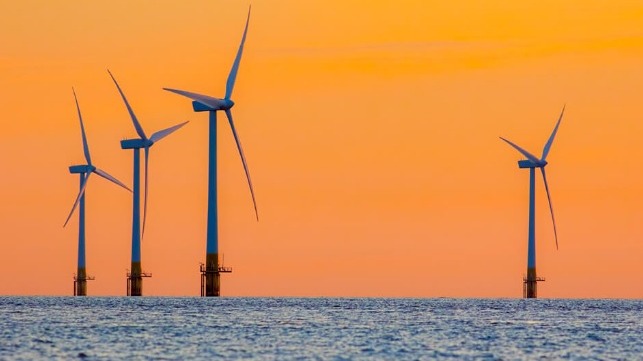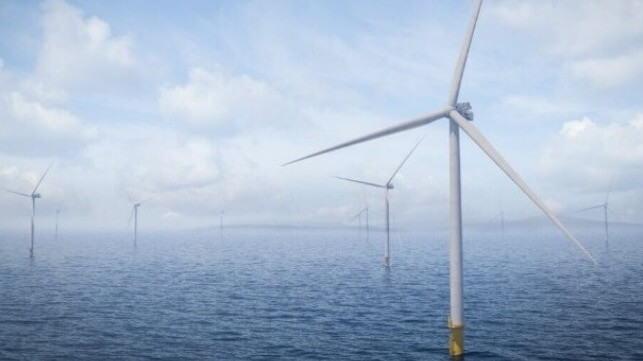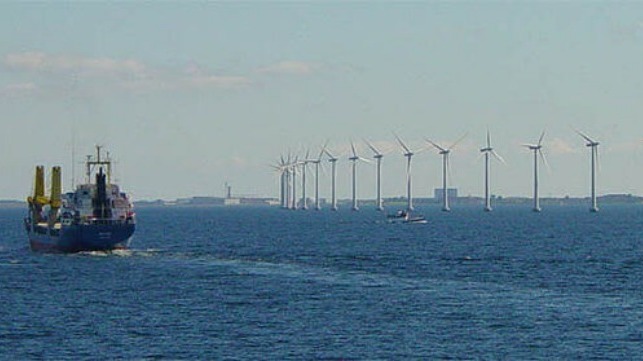Offshore’s “Blowin’ in the Wind” Problems
The bloom is off the rose when it comes to offshore wind.

(Article originally published in Sept/Oct 2023 edition.)
Bob Dylan likely wasn’t thinking about how many gigawatts of offshore wind would be installed by 2030 when he wrote “Blowin’ in the Wind.” In 1962, we were worrying about another ice age, not heat waves. Few scientists were focused on global warming and the need to cut carbon emissions.
Today, we’re swimming in a wave of green energy investments and climate change mandates, but their proponents seldom understand economics or physics. And those factors are not cooperating ? derailing offshore wind goals.
U.S. East Coast waters are being industrialized with giant wind turbines in support of state clean energy mandates. Residents are not welcoming onshore wind turbines and solar panels in their backyards as clean energy activists want. The solution? Put them in someone else’s backyard, or better yet, put them offshore where residents can’t see them.
The problem with offshore windmills is they’re expensive. According to the Energy Information Administration, offshore wind is the most expensive energy source in our repertoire, based on the levelized cost of energy calculations. The 2022 estimate for offshore wind, absent any government subsidies, is above $136 per megawatt-hour of electricity.
Even after a healthy $31/MWh subsidy, offshore wind is 165 percent more expensive than a natural gas combined cycle plant and nearly 30 percent more expensive than ultra-supercritical coal and nuclear power.
30 by 30
The U.S. offshore wind industry started in earnest in state waters in 2009 but quickly moved to federal waters beyond the three-mile state limit. A few leases were awarded in subsequent years, but in 2018 offshore wind developers began clamoring for more acreage as climate change drove demand for clean energy supplies.
The clamor was answered when President Joe Biden arrived and made offshore wind the centerpiece of his Administration’s agenda for fighting climate change. Biden established a goal to install 30 gigawatts of offshore wind by 2030. The announcement kicked off a rush to lease wind acreage along every U.S. coastline and accelerated wind farm approvals.
Offshore wind euphoria may have peaked with the February 2022 lease sale. Six leases, with 488,000 acres in the New York Bight region, were acquired for $4.37 billion. Paying $9,000 per acre was a stimulus to get projects going quickly. But lease bonuses are an anchor as profits must repay them along with financing the cost to build and operate expensive offshore wind farms, even if their fuel is free.
The pressure is intense to develop projects and get them approved rapidly.
“Unfinanceable” Projects
Six months after the lease spending spree, cracks in the industry’s foundation emerged. Last September, offshore wind developer Avangrid told financial analysts it would be seeking a “small adjustment” to its contract price with Connecticut. It also asked its utility customers in Massachusetts for a similar hike but was turned down.
Suddenly, the term “unfinanceable” entered the industry’s lexicon. Contracted power prices generated insufficient revenue to finance projects in a high-interest-rate environment.
A game of regulatory chicken began, leading to Avangrid terminating its contracts and paying its customers $48 million in penalties. Terminations were only possible once Massachusetts assured Avangrid and other developers they would be able to rebid in the 2024 offshore wind solicitation. Without such assurances, developers likely would have “walked away” from projects.
Offshore wind problems were partially driven by the huge financial losses posted by wind turbine manufacturers. The major turbine suppliers confronted sharply higher prices for critical minerals needed in the manufacture of turbine nacelles and blades. Rising labor and transportation expenses, coupled with fixed-price contracts, forced manufacturers to raise prices on new contracts. Turbine manufacturers are still struggling, so component prices are heading higher, not lower.
Avangrid led the wind developer parade in seeking higher power prices. The magnitude of developer problems emerged when Danish developer Ørsted announced a second impairment to its U.S. offshore wind portfolio this year. Previously, it suffered a $350 million impairment to a New Jersey project. Management recently told the financial community that, following a review of its U.S. offshore wind portfolio, it was worth $2.3 billion less.
Management cited raw material costs, supply chain issues, higher interest rates and a lack of clarity over its ability to receive bonus clean energy tax credits under the Inflation Reduction Act for its problems. The IRA, designed to foster development of a domestic supply chain, is a problem for offshore wind because its domestic supply chain is immature.
The industry will need to import wind turbines and components from abroad for years, as well as rely on non-Jones Act-compliant vessels for construction support. Ørsted CEO Mads Nipper proposed offshore wind developers be granted a three-to-five year “grace period” during which they would be eligible for the 10 percent bonus tax credit while developing a domestic supply chain.
An analysis of the offshore wind industry shows 17.4 GW of planned and operating generating capacity, but 56 percent or 9.7 GW is seeking price adjustments. More may be coming. To ease the cash crunch, Maryland and New Jersey agreed to give Ørsted the state’s share of IRA credits destined for residents. Will this life preserver save their projects? Maybe. However, another New Jersey developer wants its cash reward.
Pleas for Help
Recently, six East Coast governors wrote to President Biden asking for more help from the federal government to save offshore wind projects. They asked the President to direct the IRS and the Treasury Department to provide additional guidance on how offshore wind developers can qualify for federal clean energy tax credits.
They also want the government to establish a sharing program to return some of the lease bonus money to the states rather than it all going to the federal treasury. Finally, they want federal regulators to speed up permitting decisions.
The governors are desperate to get more government cash for offshore wind developers and to ease residents’ electricity bills. Speeding up permitting is questionable given that NOAA, a key regulator, has complained about the pace of permitting preventing it from doing adequate reviews.
A recent report by the New York State energy regulator examined the price hikes requested by four offshore wind farms. The report addressed their claims that inflation, supply chains and interest rates had surprised developers. An economic consulting firm, advising the regulator, said inflation and supply chain issues did surprise developers. However, it concluded developers should have anticipated higher interest rates.
That is a problem because offshore wind is capital-intensive, and its power is expensive. Power gets more expensive as interest rates rise.
The four projects requested an average price increase of 48 percent, ranging from 27 to 66 percent. The top price is above the average New York monthly electricity price. If granted, electricity prices will rise. The offshore wind price is only the price of power at the wind turbine. The power still must be transmitted to shore to be delivered to the state’s power grid. That adds more cost to the bill.
New York’s economic consultants see inflation and interest rates remaining elevated for the remainder of this decade. “Higher for longer” is not good news for offshore wind developers. They will continue dealing with expensive raw materials, largely driven by the enormity of the green energy transition. Although Wall Street analysts believe inflation will fall to the Federal Reserve’s two percent target in one to two years, the economic consultants disagree. Higher for longer inflation and interest rates guarantee more expensive electricity.
Whale Deaths
Offshore wind developers are facing challenges besides costs. The surge in whale deaths is a serious issue. Research documented that the sonar used to survey the ocean floor where turbines are to be installed is louder than claimed in company permits.
Loud underwater noise is likely responsible for disorienting whales, causing them to try to avoid the noise or go deaf. Both conditions contribute to them swimming into shipping lanes and being struck and killed by vessels.
Dead whales washing up on East Coast beaches are beginning to sway popular opinion about offshore wind. The entire legislature in New Jersey is standing for election this fall, and opinion in the state about offshore wind is sharply divided. When residents find out what will happen to their electricity bills, opinions about offshore wind may become more negative and influence voting.
Offshore wind permitting favoritism, radar interference issues, minimal climate change benefits, expensive power along with whale deaths are being investigated by the General Accounting Office. Next month a congressional hearing will be conducted. The offshore wind industry will increasingly be in the news with less positive press.
Global Issue
The U.S.’s problems are spreading worldwide. Energy technology consultancy Thunder Said Energy recently revised downward by 25 percent its 2050 forecast for global offshore wind capacity growth. Its new forecast factors in higher raw material costs and elevated interest rates.
In their view, the industry will fail to meet its installed capacity targets by about 50 percent. That will disappoint offshore wind supporters but reflects market reality.
These are not good times for offshore wind. – MarEx
Energy Analyst and commentator Allen Brooks is the author of the newsletter "Energy Musings," one of the most widely read sources in the industry.
This article appears in the September/October issue of The Maritime Executive. Since Brooks wrote this piece, the issues he outlines have continued to develop. This week Ørsted walked away from two large projects in New Jersey. It was reported that Shell has also joined with its partners is paying a fine to cancel its power purchase agreement for an offshore Massachusetts wind farm while both BP and Eversource took impairment charges against projects in New York after the state's regulators refused to reprice their power purchase agreement. The U.S. government however indicated its continuing support for the developing industry and approved Dominion Energy's offshore wind farm which will be one of the largest yet developed in the United States.
The opinions expressed herein are the author's and not necessarily those of The Maritime Executive.
Ørsted “Bounces Check” Seeking Return of $300M NJ Wind Farm Guarantee

Danish wind farm company Ørsted is reportedly seeking to get out of the guarantees it entered into with the state of New Jersey just weeks ago for the development of the two large wind farms that had been planned to provide 2.5 GW of power. According to a report from the Associated Press, the day after the company told investors it was canceling the projects, the company wrote New Jersey’s regulators saying it wanted the $200 million, which amounts to two-thirds of the guaranty, back.
Three weeks ago, New Jersey’s Board of Public Utilities approved a deal with Ørsted related to the development of Ocean Wind 1 and Ocean Wind 2. The company already had the federal approvals for the first proposed wind farm and while the second one was still under review had approvals from New Jersey for the project, both of which were central to the governor’s plan for the transition to clean energy. As part of the development of the industry, New Jersey was also working with the company to provide incentives for the development of the infrastructure including a wind port.
New Jersey Governor Phil Murphy passed a law to permit Ørsted to keep federal tax credits that it otherwise would have had to return to New Jersey ratepayers. The governor said the law was necessary due in part to the financial pressures companies were facing in developing the industry and the projects. As part of the agreement, however, Ørsted committed to completing the first phase of the project, Ocean Wind 1 by no later than December 2025 as well as other commitments to New Jersey for the projects.
The company confirmed it was committed to the projects and on October 4 began transferring the guarantee bonds to the state with the understanding they would be placed in escrow. If the projects did not proceed due to not obtaining all the necessary permitting, Ørsted was to get back the $100 million guarantee for Ocean Wind 1 and the $200 million additional guarantee for the additional projects. If Ørsted failed to meet the deadlines the monies were to be surrendered to New Jersey ratepayers.
According to the Associated Press, Ørsted has transferred $200 million of the $300 million total guarantee but wrote the state saying it wants the money back. According to the report, the company is saying the agreement was not in effect because the board had not yet ratified it.
In a Halloween surprise, Ørsted on October 31 told the state and its investors that the company had decided to cancel both of the New Jersey offshore wind farms. Earlier in the summer they had warned its U.S. wind portfolio was under review due to inflation pressures, rising costs, supply chain challenges, and an inability to realize tax credits. The company is taking a $2.8 billion charge for not proceeding with Ocean Wind 1 and a total charge of approximately $4 billion. However, they warned investors that there could be as much as $1.5 billion in additional charges due to potential contract cancelation fees and other costs.
It is unclear what will happen next as Associated Press says the agreement called for the company and the state to negotiate any disputes. Governor Murphy last week called the company’s withdrawal “outrageous.” He said the state would move to ensure that Ørsted fulfilled all its obligations.
Counting Bats and Uncertain Permits Puts Danish Wind Farm on Hold

While much of the focus in the offshore wind sector is on the growing financial challenges and uncertainties, a project in Denmark is being put on hold over objections from environmentalists on how and when the number of bats in the region are counted. The project's developers are saying it is creating uncertainty about the ability of the project to receive its permits to proceed.
The project known as Aflandshage Vindmøllepark is proposed for the southern Øresund region near Copenhagen and was to be operated for HOFOR, a utility company that provides energy, water, gas, sewage, and other services to the capital region in Denmark. The project is advanced in the planning process with the company highlighting that it is one of the few projects that was on track to be operational by 2030, a critical target date in decarbonization and the next phase of renewable energy.
The company is citing the uncertainties raised by complaints and the lack of clarity over the permitting process. They had been moving forward, including selecting Siemens Gamesa to supply the turbines before protests derailed the project. The company announced it is taking a write-down of nearly $72 million because the costs for developing the project will have to be recognized in the accounts for 2023.
"We are now putting the investment in the Aflandshage project on hold," says Susanne Juhl, chairman of the board of HOFOR. “The project will be abandoned completely unless it proves possible to continue the project in another form in the near future.”
They note the location of the project was selected with consideration for migration patterns and wildlife as well as the Swedish territorial border, the nearby airport, and busy sailing routes. The plan which was approved in the fall of 2022 calls for 26 offshore wind turbines with a total height of up to 721 feet to the top of the blade. With a total output of 300 MW, it would be able to supply green electricity that corresponds to the consumption of approximately 300,000 households.
The permit included conditions regarding the monitoring of bird and bat migration. HOFOR reports it had agreed to a counting of the bats during the construction phase for the wind farm to develop a preservation plan for when it was in operation. Potentially, the wind farm would have to stop operations at certain times to prevent bird or bat strikes.
The company’s permitting for the wind farm however was canceled in July 2023 due to complaints. The requirement for the bat count was moved to before the construction begins with the company reporting it must update the project's environmental impact report. They are saying as a result it is uncertain based on the current stipulations if they would ever receive permits. They determined that it entails an enormous financial risk for both HOFOR and the Municipality of Copenhagen to initiate the project without the necessary permits.
"The experiences from the Aflandshage project confirm the need to look at the overall authority processes in wind turbine projects,” says Juhl. “We have experienced stumbling blocks in our project that cause us to put an otherwise ready-and-ready project on hold.”
HOFOR is proceeding with the bat count because it is the minimum requirement to regain the permits. They are pointing out that as this proceeds however it raises the prospects of further uncertainties or delays as the process has been reopened for more complaints. They are working to remap the project and looking for a path forward while also warning the write-down will reduce HOFOR's ability to develop other green energy projects. Juhl concluded by saying they were confident the wind turbines and bats would have been able to live side-by-side and meet the renewable energy goals.
Top photo by Leonard G. of wind farm off Denmark - CC SA 1.0
No comments:
Post a Comment